Before Gottlieb Storz, a few other entrepreneurs tried their hand at brewing beer in North Omaha. Afterwards though, Storz dominated. For more than 75 years, his family ran Omaha’s beer industry, and even though the brewery closed in the 1970s, it left a major mark on the city that still stands today. This is a short history of the Storz Brewery.
Before Becoming Storz
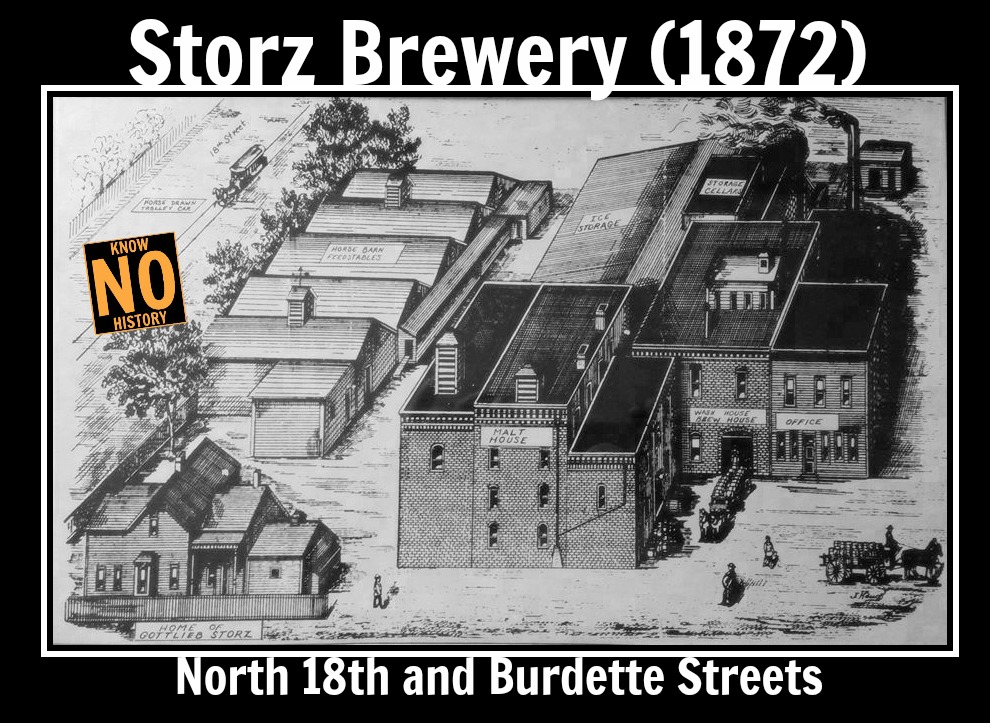
This is an 1872 illustration of the Storz Brewery at North 18th and Burdette Streets in North Omaha.
Since the beginning of Omaha, the city worked hard and played harder. Today’s downtown was packed with bars and brothels for dozens of years, and someone had to stock them with beer. Enter North Omaha’s Saratoga Brewery, Columbia Brewery, and eventually the Storz Brewery, too.
Richard Simeon was 26 years old when started the Saratoga Brewery in 1854 in the town of Saratoga. Located at the intersection of North 16th and Commercial Avenue, Saratoga Brewery was one of Nebraska’s first breweries. Located in the town of Saratoga, surely Simeon planned to supply beer to his bustling community and beyond, including Florence and Omaha City.

It was along the railroad between the bustling Sulphur Springs area and the town of Saratoga, which was located at present-day N 24th and Ames Avenue. Simeon sold his company Ebenezer Dallow in 1863, and at some point after that went to work for Frederick Metz’s brewery. Eventually he married Minna Metz, Frederick’s daughter. After his wife died young in 1881, Dallow opened a theatre in downtown Omaha.
Selling to Germans
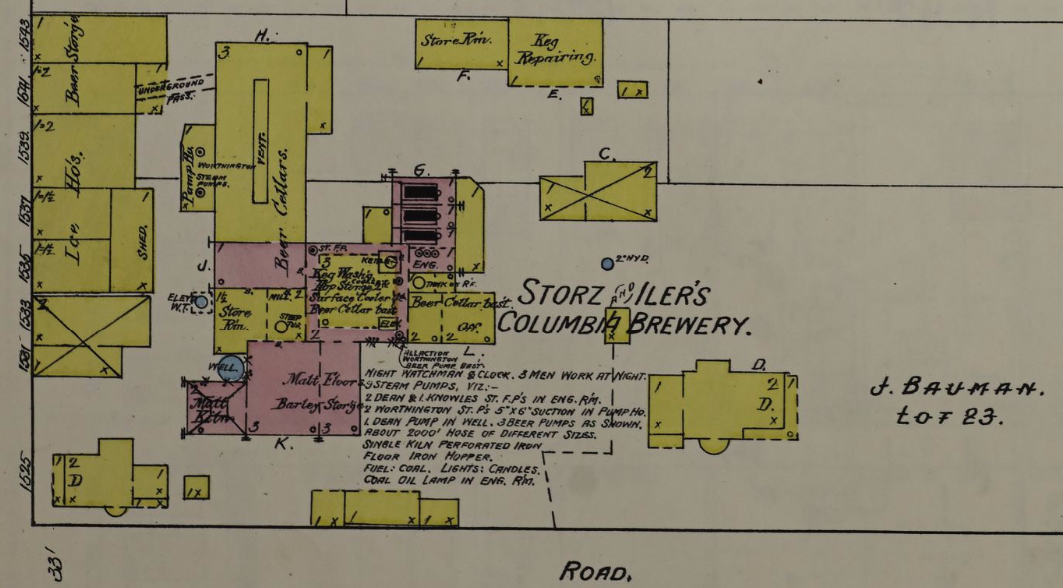
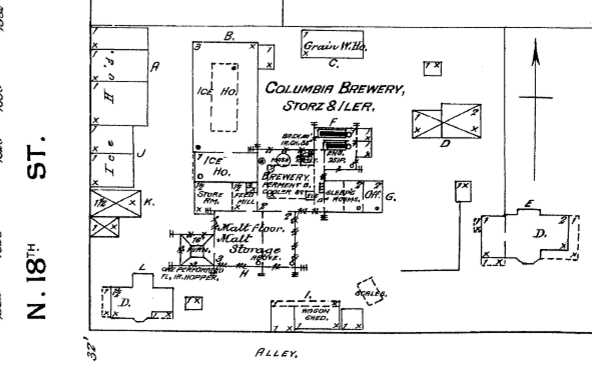
These are different maps of the Columbia Brewery run by Storz in 1872.
Dallow sold his brewery to Joseph Baumann in 1865, who renamed it the Columbia Brewery and moved it down Sherman Avenue, aka North 16th Street. In 1876, Baumann hired a young German immigrant named Gottlieb Storz. However, Baumann died that year and his widow, Wilhemina, succeeded him in running the brewery, naming Gottlieb Storz foreman.

In 1884, Storz took on J.D. Iler as a partner and they bought the brewery from Wilhemina Baumann. They built up their buildings and machinery, and increased production, and within the next two years Storz bought out Iler. He built a massive new production facility in the 1880s at 1800 North 16th Street.

In 1891, Storz founded a company called the Omaha Brewing Association to make beer and named himself as president. Naming his main brand after himself, Storz sold a lot of beer and built an empire that lasted through 1977.
Building an Empire
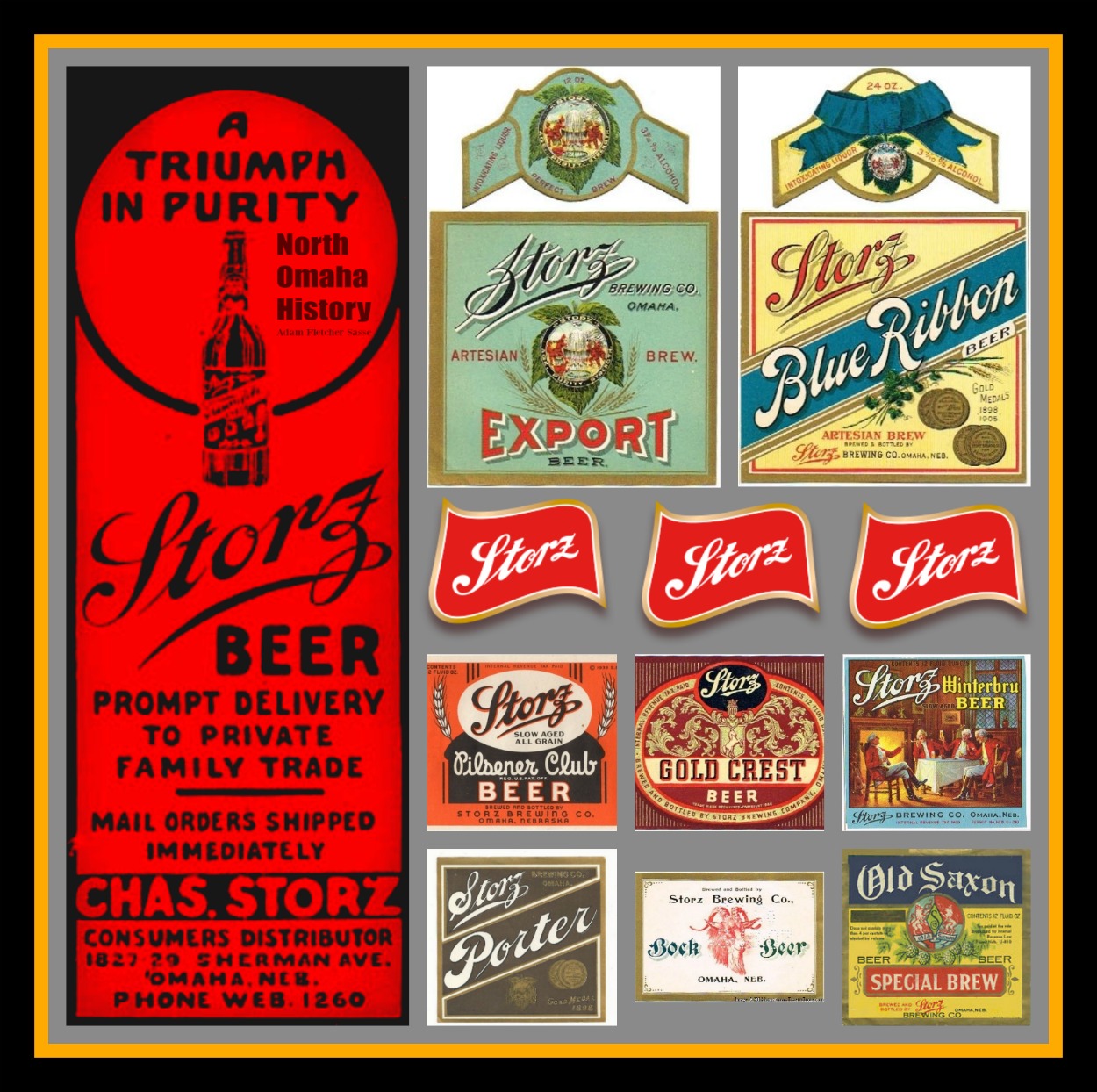
Gottlieb Storz’s plant made 150,000 barrels annually, easily making his operation the biggest brewery in Omaha. Storz kept his products high quality because he hired new brewers from Germany, and kept the business in the family. He also built alliances with other local German beer makers, and in the 1890s was instrumental in founding the Omaha Brewing Association as a lobby and promotional arm.
Storz fought big fights. Nebraska was a hotbed in the Prohibition movement, with local and statewide laws targeting the sale of all alcohol, including beer, beginning in the 1890s. In 1916, voters across the state approved a statewide Prohibition, and in January 1919 the state ratified the Eighteenth Amendment. By 1920, Storz was suffering. However, through sales of non-alcoholic beer, soda pop and ice, Storz kept going and even found success.

After the Eighteenth Amendment was repealed in 1933, Storz went back to regular production and made 150,000 barrels a year in 1935. When Gottlieb Storz died in 1939, his son Adolph became brewery president.
Over the years, Storz brewed several different labels, including Storz Porter, Storz Old Saxon, Storz Gold Crest, Storz Pale Ale, Storz Wood Duck, Storz Pilsner Club, Storz Gold Crest, Storz Winterbru, Storz Export, Storz Blue Ribbon, and Storz Triumph.
Adolph’s son Robert Storz became president of the company in the 1950s. In 1966, an investment firm from Iowa bought the company, which soon sold it to a Minneapolis beer brewing conglomerate. In 1977, they closed Storz permanently.
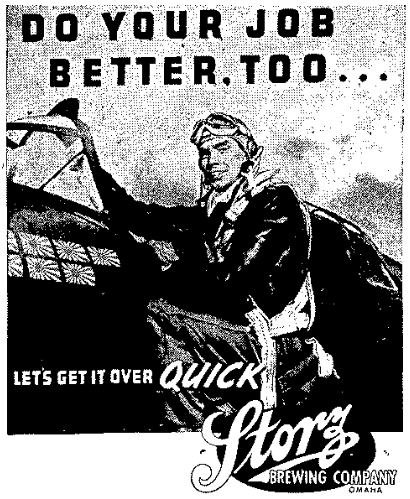
After letting the building sit empty for more than two decades, much of the brewery was demolished in the early 2000s. Today, there are a few remnants left on the site, including the iconic smokestack. Although Omaha may never see the Storz family name rise again, beer brewing in the city is making a comeback.
And that’s a history of the Storz Brewery and beer brewing in North Omaha!
Storz Beer Timeline
- 1854: Richard Simeon establishes the Saratoga Brewery at North 16th and Commercial Avenue.
- 1863: Ebenezer Dallow buys the Saratoga Brewery.
- 1865: Joseph Baumann buys the Saratoga Brewery and renames it the Columbia Brewery.
- 1872: Columbia Brewery opens a new plant at North 18th and Burdette Street.
- 1875: Joseph Baumann dies and his wife Wilhemina Baumann takes over ownership; she appoints fellow German immigrant Gottlieb Storz as brewmaster.
- 1884: Storz forms a partnership with J.D. Iler to buy the Columbia Brewery.
- 1886: Storz buys Iller’s share of the Columbia Brewery, formed the and renames it the Storz Brewery.
- 1887: Construction begins on a new plant at 1800 North 16th Street.
- 1891: Gottlieb Storz formed the Omaha Brewing Association and became the president. Other German brewers in Omaha joined.
- 1916: Nebraska approved the statewide prohibition of alcohol including beer. Storz began making soft drinks.
- 1919: Prohibition began nationwide when the United States approved the 18th Amendment banning all alcohol.
- 1933: Prohibition ended nationwide when the 18th Amendment was repealed.
- 1939: Gottlieb Storz died and Adolph Storz became company president.
- 1955: Adolph Storz retired and his son Robert Storz became president.
- 1966: Robert Storz sold the company to an investment firm in Iowa.
- 1968: A Minneapolis beer brewing conglomerate bought the Storz Brewery.
- 1977: The Minneapolis beer brewing conglomerate closed the Storz Brewery permanently.
- 1994: The largest buildings at the brewery were demolished.
- 2000: Many of the smaller buildings at the brewery were demolished, leaving only a few still standing today.
You Might Like…
MY ARTICLES ABOUT THE HISTORY OF NORTH 16TH STREET
Places: 16th and Locust Historic District | Charles Street Bicycle Park | State Bar and McKenna Hall | Storz Brewery | Warden Hotel | Grand Theater | Nite Hawkes Cafe | Tidy House Products Company | 2621 N. 16th St. | New Market | 3702 N. 16th St. | Sebastopol Amphitheater
Historic Homes: J.J. Brown Mansion | Poppleton Mansion | Governor Alvin Saunders Estate | Ernie Chambers Court aka Strehlow Terrace | The Sherman Apartments | The Climmie Apartments
Neighborhoods: Near North Side | Lake Street | Kountze Place | Saratoga | Sulphur Springs | Sherman
Events: 1898 Trans-Mississippi and International Exposition | 1899 Greater America Exposition | 1960s North Omaha Riots | “Siege of Sebastopol”
MY ARTICLES ABOUT THE BELT LINE RAILWAY IN NORTH OMAHA
Businesses:4402 Florence Blvd | 4426 Florence Blvd | 4225 Florence Blvd | Omaha Casket Company | U.S. Brush Company | Murphy, Wasey and Company Factory | Iten-Barmettler Biscuit Company | Uncle Sam Breakfast Food Company | Storz Brewery | Douglas Motors Corporation
Neighborhoods: Nicholas Street Historic District | Squatter’s Row | Near North Side | North Omaha Bottoms | Sulphur Springs | Saratoga | Bedford Place | Plum Nelly | Clifton Hill | Orchard Hill | Walnut Hill | Military Avenue
Related: Railroads | 30th and Ames | 16th and Locust | 40th and Hamilton
- A History of North 16th Street in North Omaha
- A History of North Omaha’s Saratoga Neighborhood (the first beer in Omaha was brewed here!)
- A History of Railroads in North Omaha
Bonus Pics!






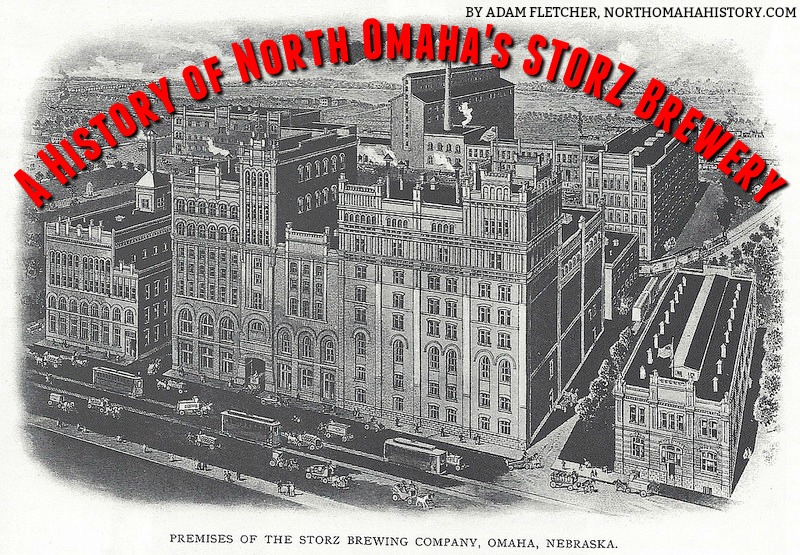



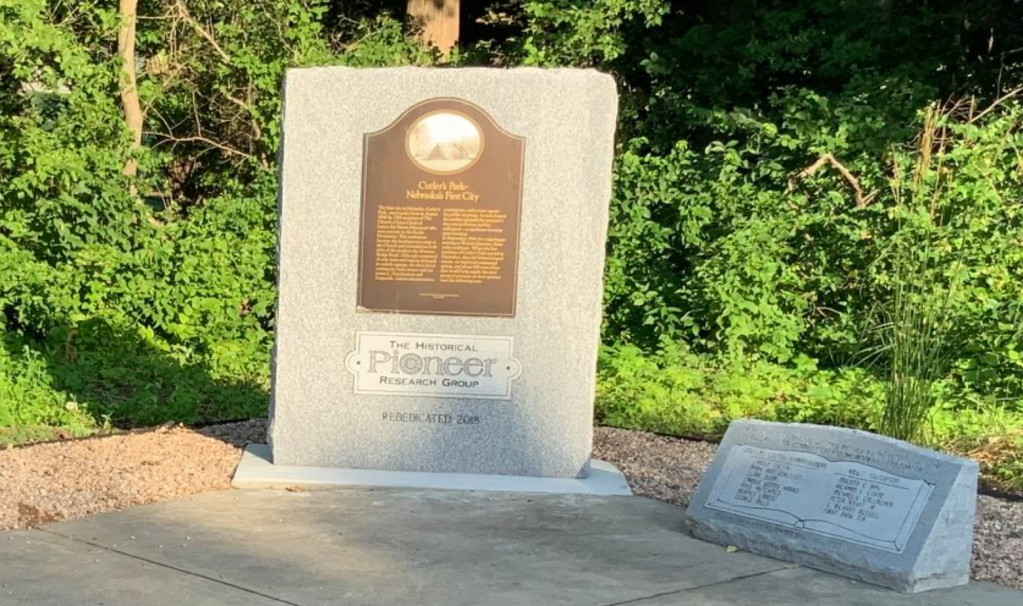
Leave a comment